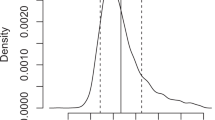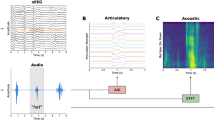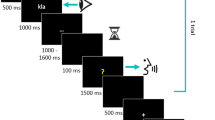Abstract
Overt articulation produces strong artifacts in the electroencephalogram and in event-related potentials (ERPs), posing a serious problem for investigating language production with these variables. Here we describe the properties of articulation-related artifacts and propose a novel correction procedure. Experiment 1 co-recorded ERPs and trajectories of the articulators with an electromagnetic articulograph from a single participant. The generalization of the findings from the single participant to standard picture naming was investigated in Experiment 2. Both experiments provided evidence that articulation-induced artifacts may start up to 300 ms or more prior to voice onset or voice key onset—depending on the specific measure; they are highly similar in topography across many different phoneme patterns and differ mainly in their time course and amplitude. ERPs were separated from articulation-related artifacts with residue iteration decomposition (RIDE). After obtaining the artifact-free ERPs, their correlations with the articulatory trajectories dropped near to zero. Artifact removal with independent component analysis was less successful; while correlations with the articulatory movements remained substantial, early components prior to voice onset were attenuated in reconstructed ERPs. These findings offer new insights into the nature of articulation artifacts; together with RIDE as method for artifact removal the present report offers a fresh perspective for ERP studies requiring overt articulation.











Similar content being viewed by others
References
Abdel Rahman R, Aristei S (2010) Now you see it… and now again: semantic interference reflects lexical competition in speech production with and without articulation. Psych Bull Rev 17(5):657–661. doi:10.3758/pbr.17.5.657
Abdel Rahman R, van Turennout M, Levelt WJM (2003) Phonological encoding is not contingent on semantic feature retrieval: an electrophysiological study on object naming. J Exp Psychol-Learn Mem Cogn 29(5):850–860. doi:10.1037/0278-7393.29.5.850
Aristei S, Melinger A, Abdel Rahman R (2011) Electrophysiological chronometry of semantic context effects in language production. J Cogn Neurosci 23(7):1567–1586. doi:10.1162/jocn.2010.21474
Brooker BH, Donald MW (1980) Contribution of the speech musculature to apparent human EEG asymmetries prior to vocalization. Brain Lang 9(2):226–245. doi:10.1016/0093-934X(80)90143-1
Costa A, Strijkers K, Martin C, Thierry G (2009) The time course of word retrieval revealed by event-related brain potentials during overt speech. Proc Natl Acad Sci USA 106(50):21442–21446. doi:10.1073/pnas.0908921106
De Vos M, Ries S, Vanderperren K, Vanrumste B, Alario FX, Huffel VS, Burle B (2010) Removal of muscle artifacts from EEG recordings of spoken language production. Neuroinformatics 8(2):135–150. doi:10.1007/s12021-010-9071-0
Dell’Acqua R, Sessa P, Peressotti F, Mulatti C, Navarrete E, Grainger J (2010) ERP evidence for ultra-fast semantic processing in the picture-word interference paradigm. Front Psychol. doi:10.3389/fpsyg.2010.00177
Delorme A, Makeig S (2004) EEGLAB: an open source toolbox for analysis of single-trial EEG dynamics including independent component analysis. J Neurosci Methods 134(1):9–21. doi:10.1016/j.jneumeth.2003.10.009
Dimigen O, Sommer W, Hohlfeld A, Jacobs AM, Kliegl R (2011) Co-Registration of eye movements and EEG in natural reading: analyses and review. J Exp Psychol Gen 140(4):552–572. doi:10.1037/a0023885
Eulitz C, Hauk O, Cohen R (2000) Electroencephalographic activity over temporal brain areas during phonological encoding in picture naming. Clin Neurophysiol 111(11):2088–2097. doi:10.1016/S1388-2457(00)00441-7
Ewald A, Aristei S, Nolte G, Abdel Rahman R (2012) Brain oscillations and functional connectivity during overt language production. Front Psychol. doi:10.3389/fpsyg.2012.00166
Ganushchak LY, Schiller NO (2008) Brain error-monitoring activity is affected by semantic relatedness: an event-related brain potentials study. J Cogn Neurosci 20(5):927–940. doi:10.1162/jocn.2008.20514
Ganushchak L, Christoffels I, Schiller N (2011) The use of Electroencephalography in language production research: a review. Front Psychol. doi:10.3389/fpsyg.2011.00208
Gratton G, Coles MGH, Donchin E (1983) A new method for off-line removal of ocular artifact. Electroencephalogr Clin Neurophysiol 55(4):468–484. doi:10.1016/0013-4694(83)90135-9
Grözinger B, Kornhuber HH, Kriebel J (1975) Methodological problems in the investigation of cerebral potentials preceding speech: determining the onset and suppressing artefacts caused by speech. Neuropsychologia 13:263–270. doi:10.1016/0028-3932(75)90002-0
Hirschfeld G, Jansma B, Bolte J, Zwitserlood P (2008) Interference and facilitation in overt speech production investigated with event-related potentials. NeuroReport 19(12):1227–1230
Hutson J, Damian MF, Spalek K (2013) Distractor frequency effects in picture-word interference tasks with vocal and manual responses. Lang Cogn Process 28(5):615–632. doi:10.1080/01690965.2011.605599
Indefrey P (2011) The spatial and temporal signatures of word production components: a critical update. Front Psychol. doi:10.3389/fpsyg.2011.00255
Janssen N, Hernández-Cabrera JA, van der Meij M, Barber HA (2014) Tracking the time course of competition during word production: evidence for a post-retrieval mechanism of conflict resolution. Cerebral Cortex 25(9):2960–2969. doi:10.1093/cercor/bhu092
Jescheniak JD, Hahne A, Schriefers H (2003) Information flow in the mental lexicon during speech planning: evidence from event-related brain potentials. Cogn Brain Res 15(3):261–276. doi:10.1016/S0926-6410(02)00198-2
Kessler B, Treiman R, Mullennix J (2002) Phonetic biases in voice key response time measurements. J Memory Lang 47(1):145–171
Kohler KJ (1999) “German”, Handbook of the International Phonetic Association: A guide to the use of the International Phonetic Alphabet. Cambridge University Press, Cambridge, pp. 86–89. doi:10.1017/S0025100300004874
Lins OG, Picton TW, Berg P, Scherg M (1993) Ocular artifacts in EEG and event-related potentials I: scalp topography. Brain Topogr 6(1):51–63. doi:10.1007/BF01234127
Maess B, Koelsch S, Gunter TC, Friederici AD (2001) Musical syntax is processed in Broca’s area: an MEG study. Nat Neurosci 4(5):540–545
Murray MM, Brunet D, Michel CM (2008) Topographic ERP analyses: a step-by-step tutorial review. Brain Topogr 20(4):249–264. doi:10.1007/s10548-008-0054-5
Muthukumaraswamy SD (2013) High-frequency brain activity and muscle artifacts in MEG/EEG: a review and recommendations. Front Hum Neurosci 7:138. doi:10.3389/fnhum.2013.00138
Nunez PL, Srinivasan R, Westdorp AF, Wijesinghe RS, Tucker DM, Silberstein RB, Cadusch PJ (1997) EEG coherency. I: statistics, reference electrode, volume conduction, Laplacians, cortical imaging, and interpretation at multiple scales. Electroencephalogr Clin Neurophysiol 103(5):499–515. doi:10.1016/S0013-4694(97)00066-7
O’Donnell RD, Berkhout J, Adey WR (1974) Contamination of scalp EEG spectrum during contraction of craniofacial muscles. Electroencephalogr Clin Neurophysiol 37(2):145–151. doi:10.1016/0013-4694(74)90005-4
Ouyang G, Herzmann G, Zhou C, Sommer W (2011) Residue iteration decomposition (RIDE): a new method to separate ERP components on the basis of latency variability in single trials. Psychophysiology 48:1631–1647. doi:10.1111/j.1469-8986.2011.01269.x
Ouyang G, Schacht A, Zhou C, Sommer W (2013) Overcoming limitations of the ERP method with residue iteration decomposition (RIDE): a demonstration in go/no-go experiments. Psychophysiology 50(3):253–265. doi:10.1111/psyp.12004
Ouyang G, Sommer W, Zhou C (2015a) A toolbox for residue iteration decomposition (RIDE)—a method for the decomposition, reconstruction, and single trial analysis of event related potentials. J Neurosci Methods 250:7–21. doi:10.1016/j.jneumeth.2014.10.009
Ouyang G, Sommer W, Zhou C (2015b) Updating and validating a new framework for restoring and analyzing latency-variable ERP components from single trials with residue iteration decomposition (RIDE). Psychophysiology 52(6):839–856. doi:10.1111/psyp.12411
Piai V, Roelofs A, van der Meij R (2012) Event-related potentials and oscillatory brain responses associated with semantic and Stroop-like interference effects in overt naming. Brain Res 1450:87–101. doi:10.1016/j.brainres.2012.02.050
Piai V, Roelofs A, Jensen O, Schoffelen JM, Bonnefond M (2014) Distinct patterns of brain activity characterise lexical activation and competition in spoken word production. PLoS One. doi:10.1371/journal.pone.0088674
Porcaro C, Medaglia MT, Krott A (2015) Removing speech artifacts from electroencephalographic recordings during overt picture naming. Neuroimage 105:171–180. doi:10.1016/j.neuroimage.2014.10.049
Protopapas A (2007) CheckVocal: a program to facilitate checking the accuracy and response time of vocal responses from DMDX. Behav Res Methods 39(4):859–862. doi:10.3758/Bf03192979
Schmitt BM, Schiltz K, Zaake W, Kutas M, Munte TF (2001) An electrophysiological analysis of the time course of conceptual and syntactic encoding during tacit picture naming. J Cogn Neurosci 13(4):510–522. doi:10.1162/08989290152001925
Sommer W, Leuthold H, Ulrich R (1994) The lateralized readiness potential preceding brief isometric force pulses of different peak force and rate of force production. Psychophysiology 31:503–512. doi:10.1111/j.1469-8986.1994.tb01054.x
Strijkers K, Costa A, Thierry G (2010) Tracking lexical access in speech production: electrophysiological correlates of word frequency and cognate effects. Cereb Cortex 20(4):912–928. doi:10.1093/cercor/bhp153
Stürmer B, Ouyang G, Zhou C, Boldt A, Sommer W (2013) Separating stimulus-driven and response-related LRP components with residue iteration decomposition (RIDE). Psychophysiology 50(1):70–73. doi:10.1111/j.1469-8986.2012.01479.x
van Turennout M, Hagoort P, Brown CM (1998) Brain activity during speaking: from syntax to phonology in 40 ms. Science 280:572–574
Vanhatalo S, Voipio J, Dewaraja A, Holmes MD, Miller JW (2003) Topography and elimination of slow EEG responses related to tongue movements. Neuroimage 20(2):1419–1423. doi:10.1016/S1053-8119(03)00392-6
Verleger R, Metzner MF, Ouyang G, Smigasiewicz K, Zhou CS (2014) Testing the stimulus-to-response bridging function of the oddball-P3 by delayed response signals and residue iteration decomposition (RIDE). Neuroimage 100:271–289. doi:10.1016/j.neuroimage.2014.06.036
Wang F, Ouyang G, Zhou CS, Wang SP (2015) Re-examination of Chinese semantic processing and syntactic processing: evidence from conventional ERPS and reconstructed ERPS by residue iteration decomposition (RIDE). PLoS One. doi:10.1371/journal.pone.0117324
Wirth M, Abdel Rahman R, Kuenecke J, Koenig T, Horn H, Sommer W, Dierks T (2011) Effects of transcranial direct current stimulation (tDCS) on behaviour and electrophysiology of language production. Neuropsychologia 49(14):3989–3998. doi:10.1016/j.neuropsychologia.2011.10.015
Wohlert AB (1993) Event-related brain potentials preceding speech and nonspeech oral movements of varying complexity. J Speech Lang Hear Res 36(5):897–905
Acknowledgments
This work was partially supported by Hong Kong Baptist University (HKBU) Strategic Development Fund, the HKBU Faculty Research Grant (FRG2/13-14/022), the HKBU Matching Proof-of-Concept Fund and Germany-Hong Kong Joint Research Scheme (G-HK012/12), the National Natural Science Foundation of China (Grant No. 11275027) to G.O. and C.Z., the Germany-Hong Kong Joint Research Scheme (PPP 56062391) to W.S, and grant AB 277 4 from the German Research Council to RAR. This research was conducted using the resources of the High Performance Cluster Computing Centre, Hong Kong Baptist University, which receives funding from RGC, University Grant Committee of the HKSAR and HKBU.
We thank Susanne Fuchs for generously supporting us with her expertise on phonetics, Joerg Dreyer and Guido Kiecker for their technical support during the EMA-EEG recording session, and Leonardo Lancia for preprocessing the EMA data and post-synchronizing the EMA-EEG data.
Author information
Authors and Affiliations
Corresponding authors
Additional information
Guang Ouyang and Werner Sommer have contributed equally to this study.
Electronic supplementary material
Below is the link to the electronic supplementary material.
Appendices
Appendix
Appendix I. Matlab Script for Experiment 1
For Experiment 1 the epoched single trial ERP data after standard artifact rejection was prepared as a three-dimensional matrix for each participant and each condition (named data in Matlab workspace). The first dimension is the data sampling points containing points ranging from −200 to 2000 ms. The data was down-sampled to 200 Hz to increase computational speed. The second dimension is electrodes and the third is single trials. The script for parameter setup and calling RIDE toolbox for the two different schemes (S + C, S + R) are as follows:
Separating the speech ERP data into S + C:

Separating the speech ERP data into S + R:

The time windows for each component were chosen to safely cover each component by visual inspection of the original ERP waveform. The time window is always relative to stimulus onset but for the R component (when the component name was named ‘r’ in the program), the time window is relative to response time (here the voice onset). That is why there is a negative value for the R time window [−500, 800 ms]. The variable ‘rt’ is the one dimension vector for response times. More details can be found in the manual from http://cns.hkbu.edu.hk/RIDE.htm.
Matlab Script for Experiment 2
For Experiment 2, the data was also down-sampled to 200 Hz to increase computational speed. The script for parameter setup and calling RIDE toolbox is as follows:

Appendix II
See Table 2.
Rights and permissions
About this article
Cite this article
Ouyang, G., Sommer, W., Zhou, C. et al. Articulation Artifacts During Overt Language Production in Event-Related Brain Potentials: Description and Correction. Brain Topogr 29, 791–813 (2016). https://doi.org/10.1007/s10548-016-0515-1
Received:
Accepted:
Published:
Issue Date:
DOI: https://doi.org/10.1007/s10548-016-0515-1




